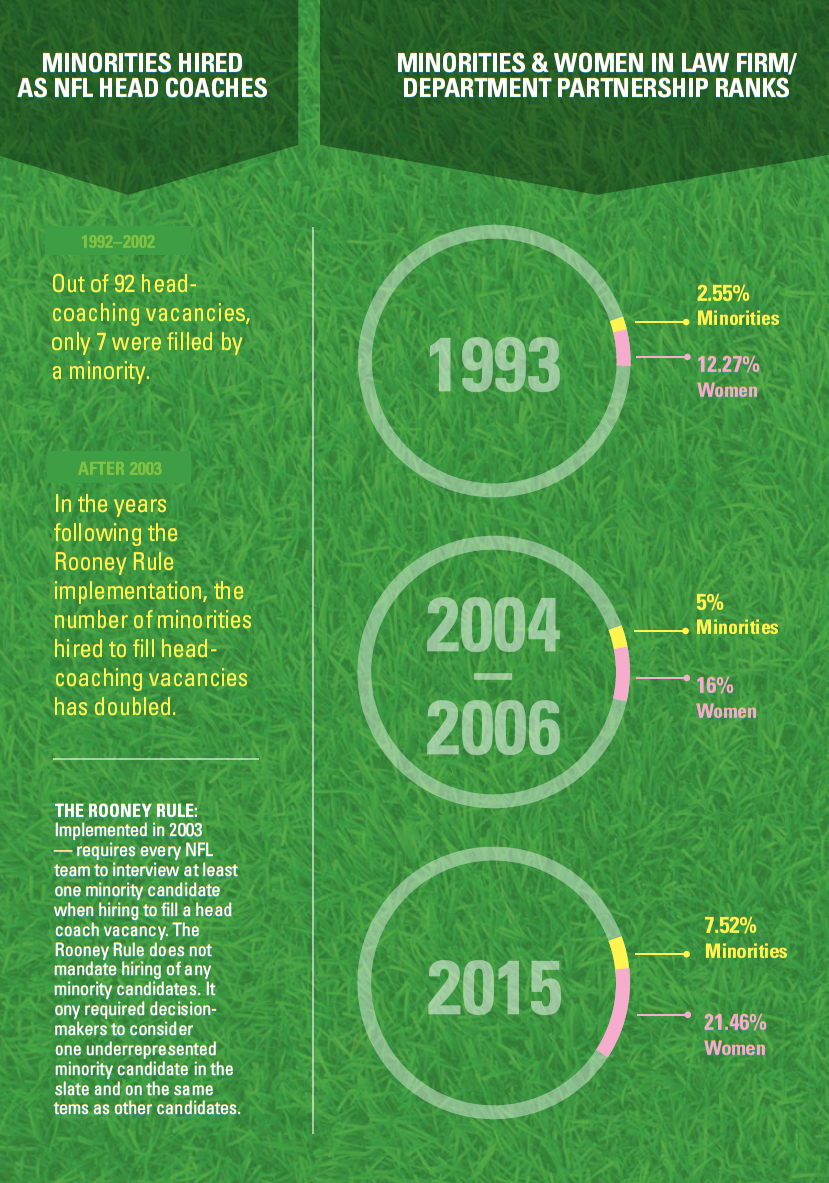
CHEAT SHEET
- Dan Rooney, remember the name. The Rooney Rule was adopted by the NFL in 2003, named for Dan Rooney, Pittsburgh Steelers owner.
- Not a mandate. The rule doesn’t force teams into hiring quotas but rather encourages them to interview minority candidates.
- Lingering inequalities. In law firms, minorities represent 7.5 percent of partners and minority women constitute only 2.5 percent of partners.
- Best practices. In a legal context, such a rule might emphasize the need to consult female or minority counsel when hiring outside legal assistance.
Year after year, organizations like the National Association for Law Placement (NALP), local and state bars, and legal publications report the most recent statistics on a range of diversity in both law firms and in house legal departments. These numbers consistently show only slight incremental progress, particularly in the law firm context.
The NALP first compiled US statistics on minorities (specifically, attorneys of color) and women in partnership ranks in 1993. That year, minorities accounted for one in 40 (2.55 percent) US partners and women accounted for one in eight (12.27 percent) partners. About a decade later, between 2004 and 2006, the New York City Bar performed a survey and found minorities accounted for one in 20 (5 percent) partners, and women accounted for one in six (<16.6 percent) partners.
Even though law school graduation rates in the United States have been approximately the same across genders for decades, and graduation rates of diverse students significantly increased, women accounted for only one in five (21.46 percent) partners in 2015, and minorities accounted for only one in 13 (7.52 percent) of partners. While the data indicates progress, it also suggests a pace reminiscent of a slow running game rather than the fun ‘n’ gun. At that speed, we are unlikely to witness parity during our lifetimes.
More appalling, however, are the statistics for minority women in the United States. The statistics show that minority women continue to be the most dramatically underrepresented group at the partnership level — numbers that are consistent across firms throughout the country, at one in 40 (2.55 percent). Corporations are seeing greater change than their law firm counterparts, but data suggests that there is still much work to be done.* Corporate legal departments value diversity and recognize the need for more specific measures and a targeted approach to addressing the concerns.
* A 2012 MCCA press release suggests that the representation of women GCs at Fortune 500 companies has grown steadily since the MCCA began tracking this information in 1999, to 21 percent. MCCA Survey: “Women General Counsel At Fortune 500 Companies Reaches New High, Press Release, “ MCCA (Aug. 3, 2012).
It appears that everyone — law firm leaders and general counsels — view the lack of diversity as a serious problem in the legal field. However, the glacial pace of progress suggests the legal needs to find new and imaginative ways to foster diversity. Enter the Rooney Rule.
According to an article in the Fordham Law Review, some GCs interviewed by Deborah Rhode have already adopted a modified Rooney Rule. See Deborah L. Rhode and Lucy Buford Ricca, “Diversity in the Legal Profession: Perspectives from Managing Partners and General Counsel,“ 83 Fordham L. Rev. 2483 (2015).
What is the Rooney Rule?
In 2002, O.J. Simpson’s famous lawyer Johnnie Cochran and labor law attorney Cyrus Mehri published a report detailing the dismal record of minority hiring in the National Football League (NFL). Although 70 percent of the league’s players were African American, only six percent of its head coaches were. From 1992–2002, the NFL teams chose a person of color to fill only seven of the 92 head-coaching vacancies.
In response, the NFL implemented the Rooney Rule, named after its most ardent supporter, Pittsburgh Steelers owner Dan Rooney. The Rooney Rule required every NFL team to interview at least one minority candidate when hiring for a head coach vacancy.
What the Rooney Rule did not do is mandate the hiring of any minority candidates. It only required decision makers to consider one underrepresented minority candidate in the slate and on the same terms as the other candidates. With the Rooney Rule’s small nudge in the hiring process, the NFL has seen a doubling in the number of minorities selected as head coaches.
The NFL’s progress in fostering diversity at the highest levels of the coaching profession suggests that the legal industry can do better by implementing the Rooney Rule to give underrepresented minorities opportunities to succeed.
How can the Rooney Rule be applied to the legal profession?
Applying the Rooney Rule to the legal profession would not require law firm and law department leaders to enact sweeping reform. Instead, it would require decision makers to add a simple step when making a decision. For example, an in-house counsel decision maker could follow this simple guideline when hiring outside counsel:
Actively seek out a minority or a female attorney (or better yet, a minority female attorney) to pitch or provide a proposal on a case where you are looking for outside counsel for each case.
This doesn’t mean an in-house counsel would have to hire any particular outside counsel or meet any quotas. This just means that for every engagement of an outside firm, a minority or female lawyer would have the opportunity to compete to lead a pitch or proposal. Many corporations today look to foster diversity by seeking out legal teams that include women and minorities. While this may well ensure opportunities at the associate ranks, we believe that something more is needed to address the lack of diversity in the partner ranks.
When asked, firm leaders attribute the underrepresentation of minorities to a lack of candidates, while they explain the lack of gender diversity by citing women’s different choices and disproportionate family responsibilities in the context of a 24/7 workplace. While we are unable to find data to back up these claims, we are fairly certain (and have anecdotally seen) that when minorities and women positively affected the bottom line, then they would be promoted more often. We believe implementing a method like the Rooney Rule can help.
In law firms, similar steps should be taken when making decisions for assignments, bonuses, or promotion. The data highlights the promotion problem in law firms when it comes to minorities and minority women. Minorities represent one in five (22 percent) associates with more than half being women. At the partnership level, those numbers fall dramatically where minorities represent only one in 13 (7.52 percent) partners and minority women represent only in one in 39 (2.55 percent) partners. The combination of providing minority and female associates with opportunities and positive feedback for their contributions will begin to shift the low numbers.
Women and minority partners at law firms
These incremental changes would add new value to these largely marginalized lawyers where the current internal structures of the firm do not regularly support their development. Moreover, it will benefit law firms and corporations alike. Recent research by McKinsey and Dr. Arin Reeves suggests that in solving problems, diversity — and the resulting more inclusive perspective — leads to better outcomes.
While we would like to see this change happen swiftly and across the legal profession, we understand that progress comes in a linear fashion. If decision makers began to apply the Rooney Rule for even a fraction of cases, this would yield unforeseen benefits.
For example, imagine an in-house counsel seeking out a minority woman senior associate in a large law firm who has the right background to pitch on a case. As suggested by the research cited above where seeking diverse perspectives leads to better outcomes, it is fairly likely that she will provide an interesting perspective or a slightly different strategy that may lead to a better outcome even if she isn’t awarded the work. In her law firm, she is seen as an attorney that received a call to pitch, the leader who put together the team and developed a strategy, rather than an associate on cases for other partners. If she provides an interesting strategy, the in-house counsel may share that with other in-house counsel, which may lead to additional pitches in the future. Just one phone call could create a new ecosystem of how work flows and how minorities and women are viewed.
Further Reading
Nov. 7, 2003 NALP Press Release.
“Where Have the Women Attorneys Gone?,” Wendy Werner, Law Practice Today (May 2004).
“How the Rooney Rule succeeds … and where it falls short, “ Ashley Fox, SPN (May 19, 2015).
Diversity Matters, Vivian Hunt, Dennis Layton, and Sara Prince, McKinsey & Co. (Feb. 2, 2015); see generally Arin Reeves, “The Next IQ: The Next Level of Intelligence for 21st Century Leaders“ (American Bar Association 2012).






